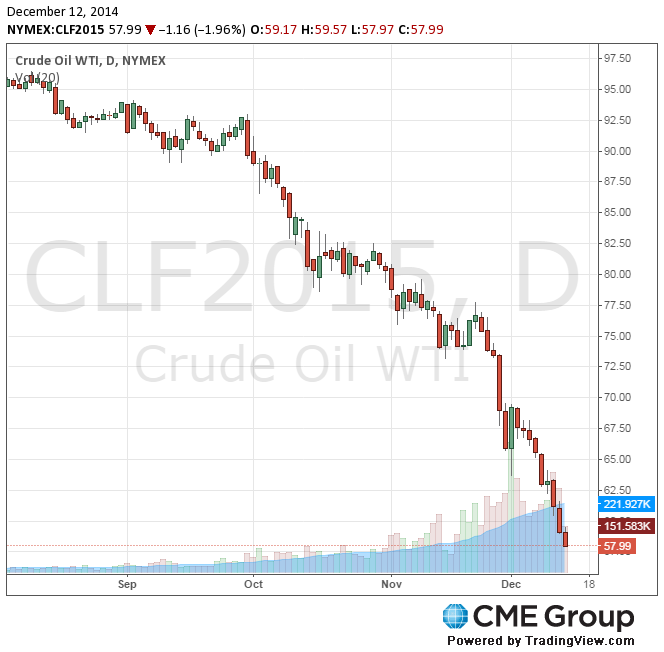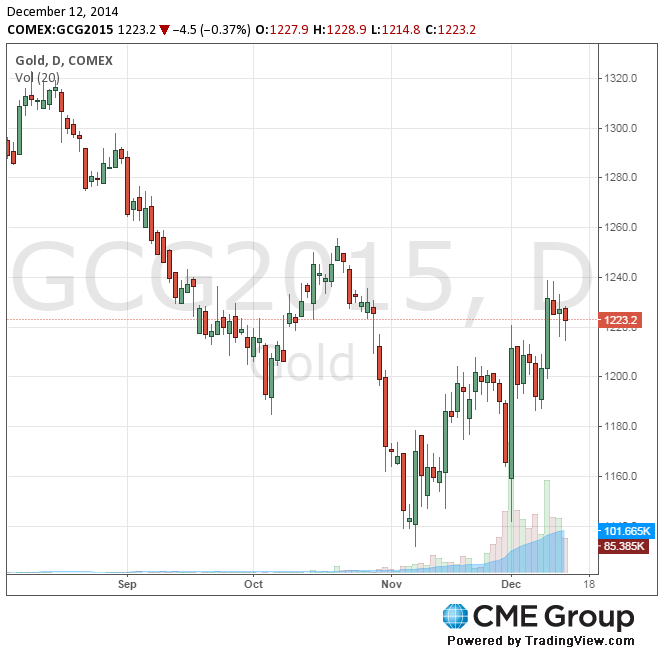Notícias do Mercado
-
16:44
Crude oil extends drop below $60 as IEA cuts forecast
Benchmark U.S. oil prices extended losses below $60 a barrel as the International Energy Agency cut its global demand forecast for the fourth time in five months.
West Texas Intermediate crude is poised for a weekly decline of 11 percent while Brent has lost 9 percent. The IEA reduced its estimate for oil demand growth in 2015 by 230,000 barrels a day, the agency said in a report today. U.S. output, already at three-decade high, will continue to rise in 2015, the IEA said.
"In the short term supply is still stronger than demand," said Gareth Lewis-Davies, a London-based analyst at BNP Paribas SA. "We are going to see further inventory builds in the first half, hence the realization of further pressure on oil prices."
Both benchmarks have collapsed about 20 percent since Nov. 26, the day before the Organization of Petroleum Exporting Countries agreed to leave its production limit unchanged at 30 million barrels a day. Saudi Arabia, Iraq and Kuwait, the group's three biggest members, this month deepened discounts on shipments to Asia, bolstering speculation that they're fighting for market share.
WTI for January delivery dropped $1.25, or 2.1 percent, to $58.70 a barrel at 10:09 a.m. on the New York Mercantile Exchange after touching $58.27, the lowest since May 2009. Total volume was about 58 percent above the 100-day average for the time of day. Prices have decreased 40 percent this year.
Brent for January settlement slid $1.02, or 1.6 percent, to $62.66 a barrel on the London-based ICE Futures Europe exchange after reaching $62.37, the lowest since July 2009. Prices are down 43 percent in 2014.
The IEA, the Paris-based adviser to 29 nations, boosted projections for supplies outside OPEC in 2015 by 200,000 barrels a day, forecasting output will expand by 1.3 million barrels a day to 57.8 million a day. Production rising faster than demand could strain some nations' ability to store oil by the middle of next year, it predicted.
The IEA cut projections for the amount of crude OPEC will need to provide next year by 300,000 barrels a day to 28.9 million. OPEC gave the same forecast, the lowest since 2003, in its monthly report on Dec. 10.

-
16:20
Gold fell
During today's trading prices for precious metals moderately reduced, but the gold market is ready to complete the growth of the second week in a row due to the increased demand for safe assets.
"100-day moving average of $ 1,234 - a level of strong resistance. The market is already three times stormed this milestone, but he resisted. If it can be overcome, the next important mark will be the 200-day moving average at around $ 1,267," - said a dealer MKS Group Jason Cherizola.
Brent oil price fell to a minimum of 5.5 years, losing 40 percent since the beginning of June due to oversupply. Cheap oil can cause a decline in interest in gold as protection against inflation.
The world's largest reserves of gold secured fund ETF SPDR Gold Trust on Thursday rose 0.13 percent to 725.75 tons.
"The longer the price stays above $ 1,200, the more new customers, why can increase reserves fund ETF. Until now, the fall in oil prices was unfavorable for gold, but if prices fall below $ 60, and the financial markets will begin to disturb the influence of low energy prices on the global economy, buying gold as a reliable asset may rise, "- wrote in the report, analysts HSBC.
Gold prices fell today after data Reuters / Michigan index value reflected potrebdoveriya 93.8, well above the forecast of 89.6.
December consumer confidence index in the US rose to its highest level since January 2007, compared with 88.8 points in November. Growth in consumer confidence in the US reflects mainly lower energy prices, improvements in the labor market and higher salaries. The Fall of the cost of gasoline allows Americans to send more money to buy other goods and services - it can expect to boost consumer spending.
Optimistic report on consumer sentiment led to a slight recovery of the US stock market, although the key indices remain in negative territory. Yields on 10-year Treasuries rebounded from daily lows at 3.5 bp to 2.145%.
The cost of the February gold futures on the COMEX today fell to 1214.80 dollars per ounce.

-
11:25
Oil: Brent Crude at new lows, WTI below USD60
Brent crude and West Texas Intermediate are trading at new lows. Brent Crude lost -1.04% trading currently at USD63.02 a barrel slipped below the 63 dollar mark, its lowest since July 2009, and West Texas Intermediate declined -1.38% currently quoted at USD59.12 as the IEA cut its demand forecast for 2015. The IEA reduced its estimate for global oil demand growth in 2015 by 230,000 barrels a day. Oil's collapse into a bear market has been exacerbated as OPEC's three largest members offered the deepest discounts on exports to Asia in at least six years. The group decided against reducing its output quota at a meeting last month, letting prices drop to a level that may slow U.S. production that's surged to the highest level in more than three decades.
-
11:00
Gold prices decline as the dollar strengthens on good data
Gold prices fell slightly, trimming weekly gains, as the U.S. dollar strengthened and oil prices continued to fall. Strong U.S. economic reports fuelled expectations that the Federal Reserve is going to hike benchmark interest rates earlier in 2015 than expected. Despite recent gains the metal is likely to remain vulnerable in the short term amid a strong U.S. economy and rising interest rates. The precious metal is currently quoted at USD1,225.00 or -0,02 % a troy ounce
GOLD currently trading at USD1,225.00
-
09:20
Press Review: Ahead of election win, Japan's Abe pivots away from painful reforms
REUTERS
Ahead of election win, Japan's Abe pivots away from painful reforms
TOKYO, Dec 12 (Reuters) - Prime Minister Shinzo Abe is signalling that retooling Japan's economy with painful structural reforms must take a back seat to reviving growth, even though he is poised to win a big referendum on his economic policies in an election on Sunday.
In the three weeks since he delayed a sales tax increase and called the election, Abe has shifted the debate from curbing the government's runaway debt to finding ways to stimulate the economy and put more money in voters' hands.
For example, policymakers say they are considering shopping vouchers for lower-income earners that would cover a portion of the cost of goods and services.
Source: http://www.reuters.com/article/2014/12/12/japan-election-economy-idUSL3N0TV3RK20141212
BLOOMBERG
IEA Cuts Global Oil Demand Forecast for 4th Time in Five Months
Global oil demand next year will be weaker than previously estimated and supply from non-OPEC producers will be bigger, theInternational Energy Agency said.
Consumption will expand by 230,000 barrels a day less than estimated in November, the Paris-based adviser to 29 nations said in a report today. Output from nations outside of the Organization of Petroleum Exporting Countries will grow at a faster pace than the agency predicted last month. Production rising faster than demand could strain some nations' ability to store by the middle of next year, it predicted.
The agency cut projections because the economies of producer nations are being hurt by tumbling prices, the IEA said. Most of the reduction in next year's estimate is attributable to Russia, where sanctions are hobbling growth, it said. Brent crude costs that collapsed 43 percent this year are too low for 10 of OPEC's 12 members to balance their budgets, data compiled by Bloomberg show.
BLOOMBERG
Ruble Surrounds Nabiullina With Rotten Choices: Russia CreditThe
Russian central bank Governor Elvira Nabiullina is running out of policy options for stabilizing the ruble without inflicting deeper damage to the economy.
On one side, she wants to support the currency to slow inflation and keep Russians from abandoning the ruble. On the other, the scale of interest-rate increases required to do that would further strangle an economy on the verge of a recession, and pile pressure on companies struggling to refinance debt as sanctions cut them off from international capital markets.
-
